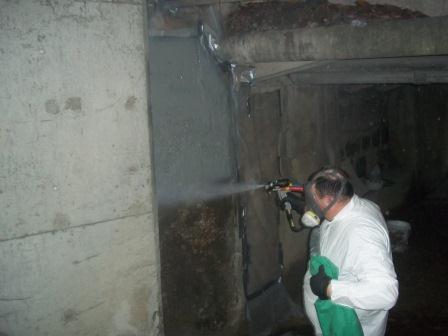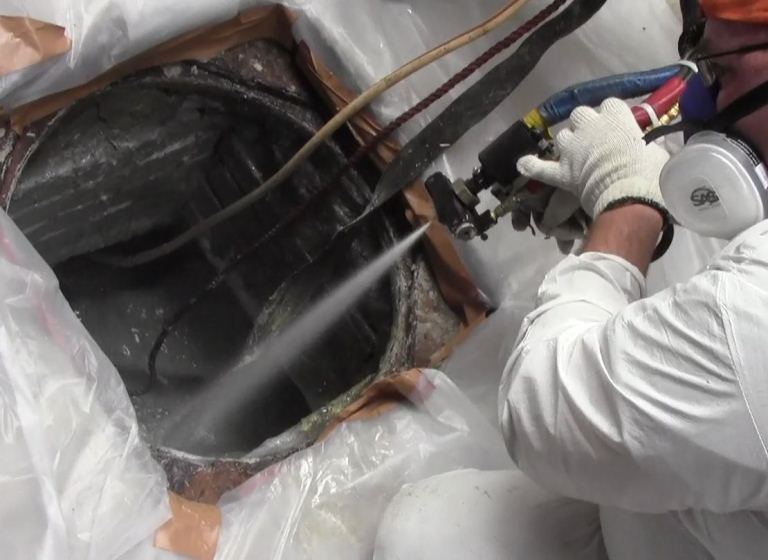Sewers deteriorate with age and typically require a high level of maintenance. In Hong Kong’s aging infrastructure, brick and mortar manholes are particularly vulnerable to cracking and crumbling. These manholes vary in depth from about 4 to 40 feet (1–12 m). Instead of patching existing problems or completely rebuilding, ArmorThane worked with their local distributor to propose a polyurea spray coating to stop deterioration and strengthen walls as a long-term solution.
International Opportunity
Hong Kong, like other densely populated areas, finds handling sewage a challenge. The network involves about 900 miles (1,448 km) of pipelines going to 280 treatment facilities, treating 713 million gallons (2.6 million L) of sewage per day.
The first step in gaining project approval was to get necessary product and equipment to Hong Kong. Because the contractor already did pipeline liner repairs, they had air compressors and generators required for the local electrical systems. However, special high-pressure spraying equipment had to be retrofitted with 380 volt, three-phase wiring and shipped from the U.S. facility. A transformer box was added to bridge the remaining differences, which is common when working on an international basis.
The second step was to demonstrate product applications and results to government officials. Rob Anderson from ArmorThane USA cleaned and sprayed a large concrete box culvert that is used to divert storm water runoff under roads. This was an easy location for the audience to watch and inspect. Because these are not brick and mortar like manholes, there is less deterioration, but the coating method is the same. Agreement was given to proceed to the final step in the approval process: a test trial.
Underground Infrastructure
 Anderson scheduled a second trip for a multi-day demonstration and training session on an actual manhole. Because sewers are a grid of underground tunnels that carry waste throughout the city to the treatment facilities, there were a number of challenges facing the task.
Anderson scheduled a second trip for a multi-day demonstration and training session on an actual manhole. Because sewers are a grid of underground tunnels that carry waste throughout the city to the treatment facilities, there were a number of challenges facing the task.
The first challenge was circumventing the flow of sewage to work on manholes and tunnels without creating significant problems upstream. Because of the extra time involved with demonstrating and training, Anderson selected a less-frequently-used line. He inserted an airbag upstream and inflated it to stop the flow. Next, the flow had to be diverted around the area to a downstream line using a trash pumping system.
Once the sewage was cleared, the surfaces had to be high-pressure power-washed and thoroughly dried before repairing. For the repairs, Anderson used ArmorCrete primer, which is specially formulated with lower viscosity than water. This allows the primer to seep into the brick and mortar to fill holes and cracks, and it completely seals weak areas. Because it prevents further cracking and crumbling, Anderson applied the primer in two coats to achieve an approximate total thickness of 3–5 mils (76–127 microns) to the entire surface rather than simply patching visibly damaged areas.
In the final step, Anderson spray-applied HighLine 510 polyurea using his own portable generator and air compressor mounted on a flatbed truck. He used a two-component pure polyurea coating that was heated and applied in two coats to yield an approximate total thickness of 60–80 mils (1,524–2,032 microns).
This polyurea was specially formulated not to react to residual moistures inherent in Hong Kong and sewer systems in general. The chemical sets quickly to form a seamless protective barrier, and it has moisture resistance and a fast cure time. This means it will not crack even as environmental conditions cause the surface to expand and contract. It is also extremely resistant to corrosive chemicals and temperature change.
Training Day
Anderson sprayed the manhole over the course of about four hours using a PMC GH40 and a PMC AP1 spray gun. The total time to work on one manhole from start to finish is 1–2 days depending on the size and deterioration of the manhole. This accommodates the steps involved in cleaning, drying, repairing, spraying, and curing.
Following the completion of the demonstration manhole, Anderson further trained six applicators, using felt pieces and bricks. This involved equipment start-stop processes, spraying action, troubleshooting, and cleanup. A training manual was created specific to manhole rehabilitation and quality assurance.
Because of the positive results on this first manhole, the city decided to move forward; the first 40 manholes have been scheduled for maintenance. In addition, concrete box culverts were also approved for repair and preventive maintenance. Overall, Anderson’s willingness to show his potential client the benefits of using this polyurea proves that a little work up front can mean a lot of business down the line!
